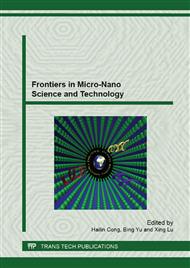[1]
R. Malarvizhi, Y. Venkateswarlu, V.R. babu, et al., Studies on removal of chromium (VI) from water using chitosan coated Cyperus pangorei. Water sci. technol. 62(2010) 2425-2441.
DOI: 10.2166/wst.2010.494
Google Scholar
[2]
H.C. Ge and S.Y. Huan. Microwave Preparation and Adsorption Properties of EDTA-Modified Cross-Linked Chitosan. J. Appl. Polym. Sci. 115(2010) 514-519.
DOI: 10.1002/app.30843
Google Scholar
[3]
P. -J. Lu, W. -W. Hu, T. -S. Chen, et al., Adsorption of copper-citrate complexes on chitosan: Equilibrium modeling. Bioresource Technol. 101(2010)1127-1134.
DOI: 10.1016/j.biortech.2009.09.055
Google Scholar
[4]
C.Q. Qin, Y.M. Du, and L. Xiao. Effect of hydrogen peroxide treatment on the molecular weight and structure of chitosan. Polym. degrad. stabil. 76(2002)211-218.
DOI: 10.1016/s0141-3910(02)00016-2
Google Scholar
[5]
X.Y. Wang and Y.M. Du. Preparation, characterization and antimicrobial activity of chitosan/layered silicate nanocomposites. Polym. 47(2006) 6738-6744.
DOI: 10.1016/j.polymer.2006.07.026
Google Scholar
[6]
X.Y. Wang, X.F. Pei, Y.M. Du, et al., Quaternized chitosan/rectorite intercalative materials for a gene delivery system. Nanotechnology. 19(2008)375102.
DOI: 10.1088/0957-4484/19/37/375102
Google Scholar
[7]
S.S. Gupta and K.G. Bhattacharyya. Interaction of metal ions with clays: I. A case study with Pb(II). Appl. Clay. Sci. 30(2005) 199-208.
DOI: 10.1016/j.clay.2005.03.008
Google Scholar
[8]
M. Ilic, E. Koglin, A. Pohlmeier, et al., Schwuger. 2000. Adsorption and polymerization of aniline on Cu(II)-montmorillonite: Vibrational spectroscopy and ab initio calculation. Langmuir. 16(2000) 8946-8951.
DOI: 10.1021/la000534d
Google Scholar
[9]
X.Y. Wang and L. Bo. Preparation and characterization of new quaternized carboxymethyl chitosan/rectorite nanocomposite Composites. Sci. Technol. 70(2000)1161-1167.
DOI: 10.1016/j.compscitech.2010.03.002
Google Scholar
[10]
M. Akcay and G. Akcay. The removal of phenolic compounds from aqueous solutions by organophilic bentonite. J. Hazard. Mater. B. 113(2004) 189-193.
DOI: 10.1016/j.jhazmat.2004.06.026
Google Scholar
[11]
L.Z. Zhu, Y.M. Li, and J.Y. Zhang. Sorption of Organobentonites to Some Organic Pollutants in Water. Environ. Sci. Technol. 31(1997)1407-1410.
DOI: 10.1021/es960641n
Google Scholar
[12]
K. Song and G. Sandi. Characterization of montmorillonite surfaces after modification by organosilane. Clays Clay Miner. 49(2001) 119-125.
DOI: 10.1346/ccmn.2001.0490202
Google Scholar
[13]
X.Y. Wangand Y.M. Du. Biopolymer/montmorillonite nanocomposite: Preparation and controlled-release property. Nanotechnology. 19(2008)065707.
DOI: 10.1088/0957-4484/19/6/065707
Google Scholar
[14]
M. Darder, M. Colilla, and E. Ruiz-Hitzky. Biopolymer−Clay Nanocomposites Based on Chitosan Intercalated in Montmorillonite. Chem. Mater. 15(2003) 3774-3780.
DOI: 10.1021/cm0343047
Google Scholar
[15]
M. Darder, M. Colilla, and E. Ruiz-Hitzky. Chitosan–clay nanocomposites: application as electrochemical sensors. Appl. Clay. Sci. 28(2005)199-208.
DOI: 10.1016/j.clay.2004.02.009
Google Scholar
[16]
M. Darder, M. Lopez-Blanco, and P. Aranda. Microfibrous Chitosan−Sepiolite Nanocomposites. Chem. Mater. 18(2006) 1602-1610.
DOI: 10.1021/cm0523642
Google Scholar
[17]
L. Wang and A.Q. Wang, Removal of Congo red from aqueous solution using a chitosan/organo- montmorillonite nanocomposite. J. Chem. Technol. Biotechnol. 82(2007) 711-720.
DOI: 10.1002/jctb.1713
Google Scholar
[18]
L. Wang and A.Q. Wang. Adsorption characteristics of Congo Red onto the chitosan/montmorillonite nanocomposite. J. Hazard. Mater. 147 (2007) 979-985.
DOI: 10.1016/j.jhazmat.2007.01.145
Google Scholar
[19]
L. Wang, J.P. Zhang, and A.Q. Wang. Removal of methylene blue from aqueous solution using chitosan-g-poly(acrylic acid)/montmorillonite superadsorbent nanocomposite. Colloid Surface A. 322(2008)37-53.
DOI: 10.1016/j.colsurfa.2008.02.019
Google Scholar
[20]
E. Assaad, A. Azzouz, and D. Nistor. Metal removal through synergic coagulation–flocculation using an optimized chitosan–montmorillonite system. Appl Clay Sci. 37(2007)258-274.
DOI: 10.1016/j.clay.2007.02.007
Google Scholar


